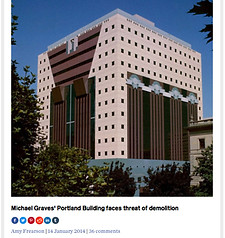A fresh proposal to makeover the Portland Building, the post-modern decorated box from 1982, includes many government amenities currently missing and desired by citizens. Newly added bigger windows, an open ground floor with plenty of circulation, un-cramped tall ceilings and green credentials are features people can expect. A public open air sky park and a sunlit vertical street, accommodating entrepreneurial vendors included in the makeover, are suited to Portland’s lifestyle.
A lightweight, earthquake resistant, tall government building including four distinct spaces for the variety of government and entrepreneurial functions, is a complete makeover of the current site. Two expansive floors high above grade are dedicated to open space functions, with a sunny roof garden 200 feet up. From here rises 10 floors with generous ceiling hieghts, then 21 floors of modest space. Above this is a public sky park and welcome center with panoramic views of Portland’s entirety. The top has 6 grand floors hosting citizens in governance departments. Views from this position remind everyone that Portland accommodates many ways to live. Operable windows and incredible views remind us of government’s responsibilities. In this large vision the existing Portlandia Sculpture is gently reinterpreted.
Back in 1980 architectural motivations were in disarray and cost efficiencies drove the process for the existing Portland Building. Simultaneously the competition included conscious use of public art. A postmodern design by Michael Graves included a future sculpture above the main entrance eventually commissioned, installed, and named “Portlandia.” The realist bronze sculpture depicts a muscular woman kneeling, looking down at citizens and offering her strong hand. It’s position is awkward and becomes lost in Portland’s large summer trees. The proposed makeover brings the sculpture down to ground and inverts the gesture. Instead of parent-like governance helping citizens (or children?) up, the new location represents a more balanced act of reaching in a fresh water reflecting pool.
Relationships of People, Governments and Sculptures –
Continuing the inversion from 20th century small city America, into today’s global Portland inventing new participative urban lifestyles, the Portland Building makeover includes space at grade for a new sculpture, forming a new relationship with Portlandia. An open stage area welcomes people’s activities to the suitably spacious civic, urban square. Together the reflecting pool, stage, and two sculptures gives the new square the artistic intrigue of Piazza Navona in Rome. It becomes a place that inspires a new kind of culture.
Careful thinking helps people considering the benefits of this large change to ongoing plans for renovation. The proposed project points in a new direction as democracy is being called to accountability across the globe. Portland’s valuable past and actions to shape it’s future, make it an exceptional place to live. Filled with diverse politics, people work together for a better Portland. The proposed makeover of the new smallTower becomes a visible example of urban American living in the twenty-first century.
smallTower and Living
The proposed smallTower makes participative government visible. It opens government to entrepreneurs. And it inspires common knowledge by joining facilities for the elderly and the young. Twenty-first century cities are designed for living. Old fashioned city planning ideas built bedroom communities to live outside the city. Modern living occurs in the city and requires many new family amenities. Kid Cities. The new smallTower enhances Portland’s culture rather than preserving Micheal Graves’ east coast idea of what Portland used to be.



The existing Portland Building is a reflection of American small city governance in the 1970s. With hindsight, we can see the Portlandia sculpture made these ideas visible: A muscular and feminine government acted as parents, offering a hand to the downtrodden, from way above. The sculpture’s realistic human form intended to provide a kind of familiarity and approachability to a distant, bureaucratic 1970s government. After the Vietnam War and an unforeseen energy crunch, the government was distant. So the existing Portland Building was in reality, a mirage, of friendliness and approachability. The design was unconcerned with the internal workings of governance or the people using the building. Tree stump as an image of government, back then. Together the sculpture and the building became a preceding physical manifestation of Ronald Reagan’s later critique: “I’m from the government and I’m here to help.”

Today people in Portland no longer see themselves as children of a parental government. Portland’s vibrant lifestyle, inclusive of the surrounding farms and metropolis, speaks to a highly participative adult–adult relationship. The success of people taking responsibility for governance and entrepreneurship, combined with an expanding global digital economy to the north and south, positions Portland for decades of urban growth. Stumptown Coffee playfully transformed an old, tongue-in-cheek, image into a smart national brand of quality. Similarly with expansive views of the metropolis, Portland is becoming a model of responsible governance for the country. And like 1980, Portland is preceding the country’s need for visible inspiration of governance with people.